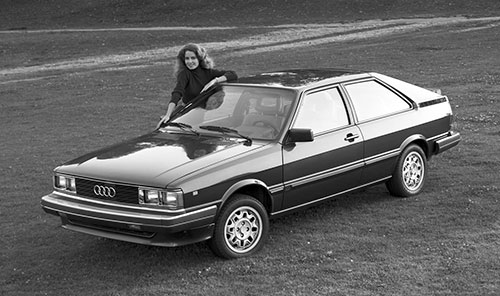
I think this might have been what I always wanted. I just didn’t know it.
I’ve written about the ’81-’87 Audi Coupe GT before; it’s a personal favorite of mine. I daily-drove a 1986 Audi 4000 quattro for a couple of years, a car that shares the Coupe GT’s interior, engine and basic structure, only with a pair of rear doors and AWD instead of the Coupe’s FWD. So I learned to really appreciate what Car and Driver lauded as an “uncluttered,” “simply and tastefully trimmed” interior coupled with “dead-nuts accurate” steering “full of road feel.” For any car with sporting pretensions, getting those elements right, among others, is a great place to start.
My ownership experience wasn’t all rainbows and sunshine, though. The 2.2-liter straight-5 made a nice burble, but 110 hp was completely inadequate when it came to moving the little sedan along with any kind of alacrity, despite the best efforts of the close-ratio 5-speed. Blame the car’s 2,800-lb weight for that.

But most significantly, I fell into what I’ll call Enthusiast AWD Delusion Syndrome. My reasoning was as follows: I appreciate the superiority of RWD over FWD the standpoint of engineering balance and how that affects the driving experience. Architecturally, my Audi 4000 was effectively a FWD car with a driveshaft, rear diff and axle shafts tacked on. In my mind, though, the mere fact that the rear wheels were driven meant it seemed more like a RWD than a FWD car. Naturally, this conceptual shift was completely at odds with the 4000’s behavior on the road, where it felt very nose-heavy, understeered resolutely and didn’t exhibit any of the fun tail-happiness characteristic of the best RWD mounts. But, just to underscore the point, my idea of the car changed when I discovered it had AWD; in my little automotive world, I felt like I was more of a true enthusiast because I hadn’t compromised and bought a FWD car, never mind the fact that the Audi’s balance and handling were, for all intents and purposes, identical to those of the layout I was trying to avoid. Furthermore, I have a feeling Enthusiast AWD Delusion Syndrome is more widespread than is generally realized, but that’s a topic to expand upon in another post.
So what does any of this have to do with the Coupe GT? Simply put, it shares all of the positives its sister car, my little 4000, and shores up the two deficiencies noted above. Is it RWD? No; it’s FWD, but it doesn’t deceive the enthusiast into thinking it’s more balanced than it is, and the lack of rear running gear nets a 400+ lb weight savings over the 4000, sharpening the car’s responses even further and, more significantly, freeing up the powerplant to shave a good second and a half off the 0-60 time. The Coupe GT is lighter, more tossable, quicker, less complicated and more straightforward than the 4000.

It’s a great looking car, too. From an aesthetic standpoint, in spite of their more prominent black bumpers, I much prefer the early, pre-facelift ’81-’84 GT to the ’85-’87 car. The refresh may share the earlier car’s proportions and stance, but in being smoothed out and cleaned up, it lost some wedgy-ness, some of the attitude of the ’81-’84 model. The earlier, boxier car share a visual kinship with the first-generation VW Scirocco and Golf GTI, good company indeed, and a pair of cars, like the Coupe GT, their automaker got just right the first time. I just wish I had known it.
Image credits: topcarguide.com, audiworld.com, coolcarswallpaper.com






























